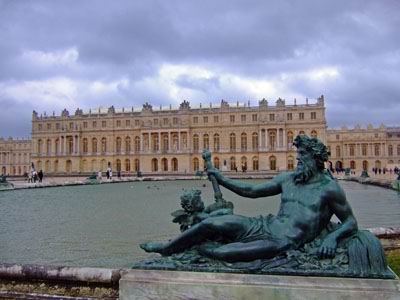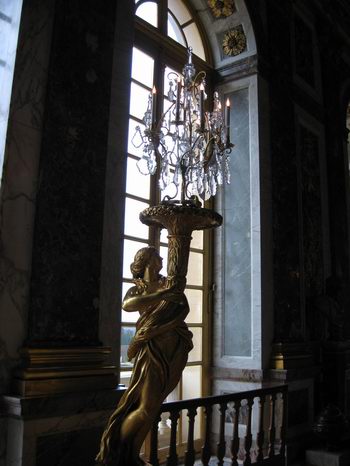- Home
- Itinerary
- Museums
- Museums
- Monuments
- Monuments
- Quartiers
- Quartiers
- Shows
- Shows
- Food
- Food
- Explorations
- Explorations
- Projects
- Projects
- People
- People
- Gallery
- Gallery
- About
- About
- Home
- Home
Versailles
With its gold, marble, glass decors, and the expansive gardens surrounding the main palace, le Château de Versailles is truly a palace fitting for a fairy tale. This famous château, constructed by Louis IV, the Sun King, is located about 40 minutes away from the center of Paris via RER (Line C). This royal palace has for the most part been restored to its former grandeur, although restoration of some of the ceiling paintings and the exterior was still taking place when we visited.

We started our tour with the main castle before exploring the gardens. The Château of Versailles was initially constructed under Louis XIII in 1623 as a hunting lodge for the King and his court of gentlemen. It was not until under Louis XIV and XV that Versailles would become the grandiose Château we see today and, in 1682, would become the official residence of the Court of France for the next century. The palace symbolizes the power of Louis XIV as the Sun King, the link between God and Earth. Everything in the furnishings of the palace boasts of the Sun King’s link with the Gods. Each of the salons of the Grand Appartement of the King was decorated to honor a particular Roman God, from Mars, God of War, to Diane, Goddess of Moon and of the Hunt. The Queen’s chambers offer a contrast to the lavishness of the King’s decors with simpler floral designs.
Between the Grand Appartement of the King and that of the Queen lies the Hall of Mirrors, one of the most famous rooms of the castle. It is an enormous room, being about 240 ft long, 35 feet wide, and 40 feet high. An entire wall is covered in mirrors made of imported Venetian glass, and the mirrors are symmetrically matched on the opposite wall by windows opening out to the gardens. The first thoughts that raced through my mind upon entering the Hall of Mirrors were all history-related—the signing of the Treaty of Versailles (1919), World War I, World War II. It was difficult to pay attention to our guide at this point. I was awe struck by the idea that I was standing in the place so frequently talked about in my European history texts.

We were very impressed by the decors of the castle—the walls, ceilings, paintings, and all the furnishings handcrafted in rich silks, velvets, gold and marble. Although we would have probably been impressed by Versailles just by touring it on our own, our wonderful guide, Vincent, whose vast knowledge of Versailles was very impressive, added to our experience. (-Carmel)